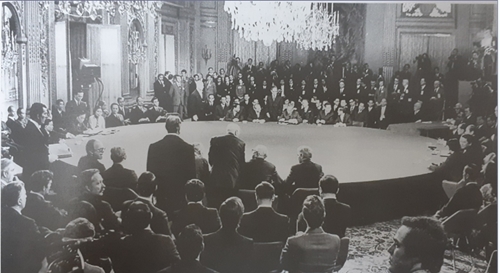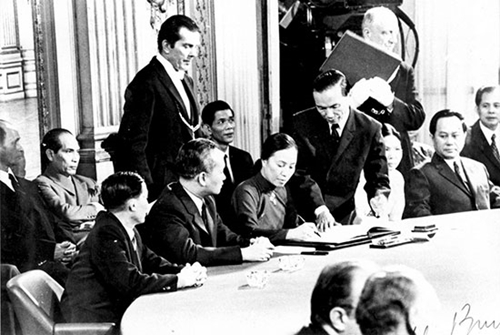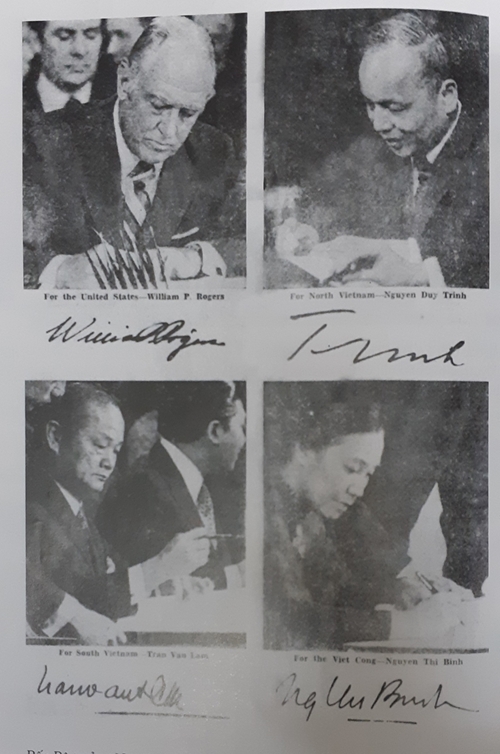Good coordination
At the age of 94, journalist Ha Dang, a former member of the negotiation delegation of the Provisional Revolutionary Government of the Republic of South Vietnam, was still quick-witted and remembered every detail of the negotiations in Paris half a century ago. He said, at the Paris Conference where Vietnam fought against the U.S. to save the country, Vietnam sent two negotiation delegations: The delegation of the Democratic Republic of Vietnam and the delegation of the National Liberation Front of South Vietnam, which was later named the delegation of the Provisional Revolutionary Government of the Republic of South Vietnam.
    |
 |
|
At the signing ceremony of the Paris Agreement on ending the war and restoring peace in Vietnam on January 27, 1973 (An archived photo) |
At the conference table, our two delegations holding different positions but sharing the same goal gave us many advantages to coordinate to fight, said journalist Ha Dang.
In realizing Uncle Ho's teachings at the fifth diplomatic conference on March 16, 1966, the two delegations excellently performed their roles and positions. They followed their assignments and coordinated smoothly during the entire negotiation process, from determining solutions for each period, each session to giving solution initiatives at public forums or private meetings.
As a member of the negotiation delegation, journalist Ha Dang was tasked with drafting speeches for the head delegate Nguyen Thi Binh. He recalled that although the delegations of Democratic Republic of Vietnam and the Provisional Revolutionary Government of the Republic of South Vietnam were separate, they met once a week. The meetings of the Paris Conference were held every Thursday, lasting several hours. There were meetings opening at 10a.m. and closing at 5 or 6p.m. After a tense meeting, our two delegations met on the following day in Choisy-le-Roi where the delegation of the Democratic Republic of Vietnam stayed to review and draw lessons and make orientations for the next meeting of the Paris Conference.
Right on Friday evening, in the spirit of the morning meeting, he (journalist Ha Dang) prepared documents for the speech. On Saturdays and Sundays, when the delegation members went to different places to mobilize and call for the support of French people and overseas Vietnamese, he sat in a small room and wrote the speech.
“I showed the draft speech to Ms. Binh before sending it to the delegation of the Democratic Republic of Vietnam on Monday morning for Mr. Le Duc Tho and Xuan Thuy’s comments. If corrections or additions were needed, I corrected it and returned the manuscript to the Northern delegation on Tuesday evening. After the two delegations agreed on the content, the draft speech was translated into French which was the main language at the conference,” journalist Ha Dang said.
According to the journalist, when writing a negotiation speech, the collective opinions were very important, but sometimes comments were different that made the person who wrote the speech feel hard to please all.
Sitting quietly for a few seconds, he slowly said that, “Once, when I finished writing a speech, with the consensus of all delegation members, I sent it to Mr. Xuan Thuy and Le Duc Tho for approval.
    |
 |
|
Minister of Foreign Affairs of the Provisional Revolutionary Government of the Republic of South Vietnam Nguyen Thi Binh signs the Paris Agreement on Vietnam on January 27, 1973. (An archived photo of the Ministry of Foreign Affairs) |
The article was sent back with the edited content, including a sentence that ‘The crime of the U.S. imperialists in South Vietnam would not be washed away, even if the East Sea were drained off.’ Everyone in the delegation thought that the sentence must have been edited by me because the tone was more like a newspaper article than a negotiation speech. I let everyone finish talking, then took the manuscript with the words of Mr. Le Duc Tho and said, ‘This is Mr. Le Duc Tho's opinion.’ Everyone shouted, showing extreme gratefulness to Mr. Le Duc Tho.”
In France, head delegate Nguyen Thi Binh and some members of the delegation of the National Liberation Front of South Vietnam/ Provisional Revolutionary Government of the Republic of South Vietnam were arranged to stay in Verrières-le-Buisson to the Southwest of Paris for nearly 5 years (1968-1973). Other members of the delegation stayed in Massy, a suburb of Paris.
“Initially, I was arranged to share a room with other delegation members in a large room. To write articles, I often sneaked into Luong Xuan Tam’s photography room. Though it was dark I could concentrate. When going to Massy to visit the delegation members, Ms. Binh asked for a small room for me to be convenient for writing. I was arranged to sit in a kitchen of about 6sq.m. with a bed and a desk. I was there for five years in a row drafting speeches,” journalist Ha Dang recalled.
The art of ingenious diplomacy
During the negotiation at the Paris Conference, the motto “To use the invariable to cope with variables” according to Uncle Ho’s teaching was deeply embraced and consistently implemented by the heads of delegations and members during the negotiation process.
According to Uncle Ho's teachings, “the invariable" consisted of many contents. That was the goals to be achieved that the U.S. must recognize Vietnam's independence, sovereignty and territorial integrity,” and “U.S. troops must be withdrawn, while our troops stay.” That was the spirit of independence and self-reliance and principled requirements of the close cooperation between politics, military and diplomacy, between national unity and international solidarity, between raising the flag of national justice and launching public opinion to expose the opponent’s schemes and tricks, taking advantage of international sympathy and wide support across all continents in order to win step-by-step towards the entire victory.
Meanwhile, at the Paris Conference, the “coping with variables” was embraced and actualized with the skillful compromise strategies and principled flexible concessions to take advantage of the opportunity to achieve the victory step-by-step. The “coping with variables” was also shown in the creative thinking to find forms and measures of solidarity and suitable struggles for each partner and subject in a specific situation.
    |
 |
|
Representatives of the four parties sign the Paris Agreement on Vietnam on January 27, 1973. (An archived photo) |
When still alive, Ambassador Nguyen Khac Huynh, a former member of the delegation of the Democratic Republic of Vietnam, once emphasized that, at the Paris Conference, Vietnam skillfully applied the art of “fighting-negotiating,” the art of making use of negotiations to serve military and political struggles.
The negotiations in Paris lasted for nearly 5 years, but the actual negotiation time was only about 7 months (1968: 2 months; 1972 and 1973: about 5 months). Most of the time and effort was for the fight of public opinions and serving the battlefield.
To that end, both Vietnamese delegations maintained and combined the two forums, attaching great importance to the struggle in the public forum; and at the same time, treasuring all three main activities of the two delegations, including fighting at the meeting, mobilizing the press, and mobilizing movements.
While upholding our cause and goodwill, we ceaselessly denounced the U.S. crimes; criticized and rejected the U.S.’s tricks to limit our fight such as demanding the two sides to de-escalate, withdraw troops together, restore the demilitarized zone, cease fire in Indochina, among others. It can be said, the negotiations effectively supported the theater, helping us to win on both diplomatic and battlefield fronts.
Translated by Mai Huong